Exploring the Significance of Health and Social Care
Introduction
The health and social care is referred to the field that is involved with offering treatment to the individuals with ill health and deteriorated medical condition at hospitals, community and health centres (Glasby, 2017). The health and social care involve the elements of nutrition, biology, sociology, law and ethics. The health and social care is significant as it helps to provide emotion, social and physical support to individuals in improving their lives to live in a better and healthy way. There are different types of research executed in health and social care which are qualitative and quantitative research. The qualitative research includes the collection of secondary data from existing literature as wellas gathers opinions and perfection of people regarding a certain topic. The quantitative method involves collection of numeric or statistical data through survey (Glogowska, 2015).
In this proposal, the aims and objectives of the study are to be mentioned at the initiation of the study. The proposal is then going to investigate the background of “Depression among young people” by considering the current and past evidence. It is to be followed by mentioning the research methodologies to be used and their importance in the study. The qualitative and quantitative along with otology and epistemology is to be discussed. Later, the different types of literature are to be discussed along with the type of literature to be used in the proposal is to be mentioned. The overview of the literature also going to inform the rationale of choice of six pieces of literature and they are to b critically appraised with the help of the CASP tool. The proposal is to be concluded with the ethics to be considered and briefconclusion of the information mentioned in the entire proposal.

Research Aim
The aim of the study is to determine the way depression affects young people in society.
Research Objectives
The objectives of the study are:
To identify the factors which lead to depression among young people
To evaluate the impact of depression on young people
To analyse the challenges faced by young people due to depression in society
To recommend ways in which the young people can be able to cope with depression in society
Background of the study
The depression is referred to the mood disorder which leads an individual to develop low mood and lack of interest in performing everyday activities (Cruwys and Gunaseelan, 2016). In the current era, depression is one of the common mental health issue faced by many individuals and mainly young people. This is evident as in many countries it is found that depression is the primary driver of mental disability among people of all ages. In 2014, it is reported that in the UK nearly 19.7% of people who are above the age of 16 and overexpressed symptoms of anxiety and depression. The figure shows a sharp increase in the rate of depression and anxiety by 1.5% from 2013 (mentalhealth, 2019). This indicates that depression is rising exponentially among young people in the UK with progressing years.
In 2017, the report published by the NHS Digital informs that 1 in 12 people in the UK who are between 5-19 years of age have emotional disorder and out of them 2.1% have depressive disorder. Moreover, it is informed that 16.9% of people between the ages of 17-19 years are seen to have a mental disorder. Among them, 4.8% of individuals are suffering from depression. In the study, the women within the age group are found to be twice likely facing depression and other mental health issues than the boys (NHS, 2018). This indicates that young people with progressing age are facing depression and the girls are more vulnerable to develop depression compared to the boys. The NHS reports mention there is 46.8% risk that young people between 17-19 years of age who have mental disorder to be involved in self-harm and the women are found to be at most risk (independent, 2018). This informs that young women have more vulnerable health condition due to depression compared to men. Therefore, the study is important to be executed so that the causes and factors leading to depression among young people in society can be identified. Moreover, the risk factors and impact of depression among the young people can be understood through discussion in the study which is required for developing awareness and treatment methods to resolve the challenges faced by young people as a result of depression.
Research Methodology
Looking for further insights on Lifecourse Approaches in Health Social Care? Click here.
In research, there is already confusion between the meaning of methods and methodology as they are found to be similar in nature. However, both are widely different even though they rhyme the same as methods are specific tools whereas methodology is the rationale for using the tools in the study. According to Jacobsen (2016), the methods are referred to the tools and techniques which are used for resolving the raised research question in the study. In contrast, the methodology is referred to the process of selecting, identifying, processing and analysing information regarding a topic through the use of different techniques and tools (Green and Thorogood, 2018).Thus, the methodology informs the principles which are used as guidance for executing research practices.
The research methodologies are of three types that are quantitative research methodology, qualitative research methodology and mixed researchmethodology. The quantitative research methodologies emphasise to use objective measurements and execute numerical or statistical analysis of data that are gathered through questionnaires or survey by manipulating the previously existing data through the use of computation methods (Guetterman et al. 2015). In contrast, the qualitative research methodology emphasises on gathering non-numerical data through observation and consideration of the feelings, concepts, characteristics, presences and description of things by other individuals (McCusker and Gunaydin, 2015).The mixed research methodology includes the use of qualitative as well as quantitative methods in framing the study so that strength of one of the methodology is able to resolve the limitation of another to frame an enriched study.
The strength of quantitative methodology is that it allows the findings to be generalised, collected in less time, analysed in an easier manner and ensure consistency of data. However, the limitation of the quantitative methodology is that it does not allow robust data to be collected leading the knowledge gathered to be abstract in certain situations (Morse, 2016). The strength of qualitative methodology is that it provides in-depth data along with enriched information by mentioning the perception, feelings and concepts of the respondents. Moreover, it helps to unravel the complex phenomenon involved in the local context and perception of the individuals (McCusker and Gunaydin, 2015). However, the limitation of the qualitative methodology is that it is time-consuming and interpretation of the information is usually made in biased was as it is influenced by the perception of the researcher (McCusker and Gunaydin, 2015).
The research onion by Saunders is the pictorial image which is created based on excluding philosophies that are the ontology, epistemology and axiology. The choice and understanding of the research philosophies are important as it assists in effective planning and execution of the study and therefore the three philosophies are mentioned outside the key onion. The ontology and epistemology are the two different ways in which a research philosophy can be observed. The ontology mainly deals with reality and considered belief which is reflected by the interpretation of an individual (Scotland, 2012). However, epistemology is the theory in which knowledge is gathered through the use of different methods and by considering validity and scope along with creating distinction between justified opinion and beliefs (Scotland, 2012).
The research philosophies mentioned under the research onion created by Saundersinclude positivism, interpretivism, pragmatism and realism. The positivism research philosophy considers collection of data and information based on scientific methods and facts (Saunders et al. 2009). The pragmatism research philosophy considered the facts to be relevant only if they are supported through proper actions. The realism philosophies mainly rely on the idea which is independent of the human mind and reality (Saunders et al. 2009). However, interpretivism is the process in which elements of the study are interpreted by integrating human feelings and interestregarding the study (Saunders et al. 2009).In this study, the positivism philosophy will be used as it will allow the researcher to logically as well as critically investigate the collected facts and information regarding the study to resolve the raised research question.
In this study, the mixed research methodology for systematic review will be used. The mixed methods systematic review is referred to the process in which both quantitative as well as qualitative literature based on a specific subject area is analysed and appraised to synthesis the findings and mention results of the study (Tariq and Woodman, 2013). The strength of using mixed methods systematic review is that it allows multiple facts to be used to explore facts in the best way by using quantitative or qualitative methods (Tariq and Woodman, 2013). Therefore, to seek broader perspectives on the topic the mixed methods systematic review will be used.
Literature Review
The literature review referred to the scholarly article that includes present knowledge and findings along with methodological and theoretical contributions made by several authors regarding a certain topic. The literature reviews are secondary data resources and they do not inform any original or new research work of authors (Greenhalgh et al. 2018). The different types of literature reviews aresystematic review and narrative literature review. The systematic review is referred to the literature review where systematic methods are used for gathering secondary data, synthesising qualitative or quantitative results and critically analysing and appraising studies (Greenhalgh et al. 2018). However, narrativereviews aretraditional literature review in which critical, comprehensive and objective analysis of the present information regarding a topic is analysed to develop a theoretical framework to focus on the context of the study topic (Hinton and Kirk, 2016). In this study, the systematic literature review method is to be used in framing the literature review as it allows analysing the quality and validity of information in the study in an effective way (Greenhalgh et al. 2018). The narrative review is not to be used as it includes bias as well as explicit criteria are not considered in selecting and evaluating journals and articles for gathering information (Greenhalgh et al. 2018)
The Evidence-based practice (EBP) is referred to the process in which information from the best research practice with proper patient value and clinical evidence is used by healthcare practitioners with the intention to offer improved patient outcome (Wilson et al. 2015).The importance of EBP in health and social care is to provide most efficient and effective healthcare to the patients by taking care decision based on the identified evidenceand ensure finite healthcare resources are used wisely (Birken et al. 2018). The evidence to be used in EBP are collected through systematic reviews, analysing best patient practice and accessing clinical as well as practical guidelines mentioned to support clinical practice. Thus, the literature review of clinical and medical articles and journals are required to provide evidence to be used to implement EBP to care for patients. In order to create an evidence-based practice for understanding the topic of depression among young people, the CASP tool is to be used. The CASP tool has the key aim to assist researchers develop skills in analysing and making sense of evidence by allowing them to understand the way articles and journals are to be critically appraised (Gilmartin et al. 2017).
The literature review for “Depression among young people” is to be developed by using the CASP tool. The papers to be chosen for the literature review are to follow the inclusion criteria of being published after 2015, written in English, related to depression among young people and academic in nature. The exclusion criteria for the papers include journals or articles published before 2015, not written in English, non-academic and related to depression in children and older people or any specific community. The articles before 2015 are excluded and after 2015 are included in the study so that most current, updated and relevant evidence are gathered and backdated information avoided. The paper written in English are chosen and non-English papers are excluded as the researcher has understanding of English Language only. The academic papers provided the most relevant evidence and so they are selected. Since the topic is regarding depression among young people, thus impact and facts regarding depression of children and older people are avoided to ensure enriched and valid execution of the study.
The evidence regarding relevance, resonance and credibility of the paper for the literature review is ensured through the CASP tool is presented in the Appendix. (Refer to Appendix 1)
The key aim of the paper is to analyse the risk of depression among young adults due to their experience of early childhood parental death. The study used register-based method where they gathered data from the Swedish National Registers along with hospital admission and outpatient care for depression from 2006-2013 in the UK. This acts as strength for the study as the data gathered from governmental sites are found to have low attrition and high validity indicating less error in study being experienced (Berg et al. 2016). Moreover, data gathered from the hospital and outpatient care allowed comparison of different forms of depression experienced by young people (Berg et al. 2016). In the study, it is mentioned that no informed consent from the participants is taken for using their information. Thus, it acts as limitation for the study because ethical consideration may not have been achieved as personal data of people is being used without their prior consent.
The findings of the study inform thathazard ratio of 1.19 in men and 1.15 in women for depression were experienced who were accessing parental psychological outpatient care for overcoming maternal death due to natural causes. This indicates that parental death act as a major cause of depression among young people and men are found to be more at risk of depression compared to women due to loss of their mother at early age.The finding is supported by the study of Feigelman et al. (2017) where it is informed that young people are prone to experience depression due to parental death in childhood days. The findings also informed that young people losing parents at teenage years are at increased risk of developing depression compared to children losing their parents at the pre-school stage.
The use of social media is to be increasing among the young adults in the US and it has led to rise of associate mental health disorder in the society. The study has the key aim to determine the way social media use is associated with depression among young people.In the study, survey method is used where 1,787 adults between the age of 19-32 years using social media and have depression were considered (Lin et al. 2016). The recruitment of the participants is done through address-based sampling and random digital dialling. The social media among the participants was examined through self-reported total times per day and depression was measured by using Patient-Reported Outcomes Measurement Information System Depression Scale. The limitation of using digital sampling and address-based sampling is that variability in data may be experienced which would lead to degrees of error in data collection (Katz et al. 2017). However, the strength of using the online sampling method is that it allowed researcher to gather large sample for conducting the study, in turn, helping them to develop mean values with better accuracy (Lin et al. 2016).
The results inform that compared to people who use social media for low amount of time per day experiences less odds of depression compared to young people who use social media for more times per day. This is evident as 19.4% of people who use social media for 0-8 times in a week were found to be highly depressed compared to 28.7% people having high depression who use social media for more than 58 times in week. Thus, social media use has a significant impact on the development of depression among young adults. The fact is supported by the study of Woods and Scott (2016) where it is mentioned that increased social media use among young people is leading them to develop sleep deprivation, anxiety along with depression as well as low-self esteem. The limitation of the study is that error in analysis may have been raised due to large sample size and lack of “gold standard” measures being used for social media exposure analysis. The other limitation is that the study has failed toexecute complete clinical diagnosis of depression among the participants which may lead the study to fail in providing proper clinical evidence regarding the way social media use leads to depression among young adults.
The aim of the study is to examine relation between loneliness and isolation along with their relation with depression among young people and whether the association is able to be explained through genetic influences. In the study, the data is gathered from age-18 of the Environmental Risk Longitudinal Twin Study which is report of birth cohort of same sex twin born in Wales and England in 1994-95 (Matthews et al. 2016). Moreover, regression analysis is executed in the study to determine differences in results of relation of loneliness and isolation with depression. The use of regression analysis acts as strength for the study as it helped the researcher to determine the relationship between the independentand dependent variable in the study (Sheets et al. 2017).
Thefindings of the study inform that loneliness and social isolation both are correlated at a moderate level (r=0.39) but both are found to be intricately related to depression. In the regression analysis, it was found that loneliness is more intricately and robustly related to depression among young people. The study by Ebesutani et al. (2015) supports that loneliness leads young people to become depressed as they feel isolated. The limitation of the study is that it used self-report analysis which may have lead to bias in gathering data. Moreover, the data measured are for the same aged individuals that do not offer permission to conclude the results on the association of the variable on individuals of other age.

The telomere length is hypothesized to be one of the markers for cumulative exposure towards stress and stress is regarded to be the cause of anxiety and depression among young adults. The study aims to analyse the relation of telomere length with depression and anxiety. The study used population-based sampling as the data are collected from the National Health and Nutrition Examination Survey 1999-2002 (Needham et al. 2015). This acts as strength for the study as it mitigates the risk of selection bias of participants which may be present in studies where the clinical population is used as the participants in the study are chosen from the overall populationrather than the selective population as seen in clinical field (Needham et al. 2015).
The findings of the study informthat depression is not related to telomere lengths among young people. The limitation of the study was that capturing telomere length may contribute to characteristics regarding biological ageing which involves risk regarding different diseases. In addition, it is possible that telomere length and depression are only associated with older age and therefore finding it among young people is limitation of the study (Needham et al. 2015).
The study informs that chronic sleep deprivation may create increased risk for depression among young people who are vulnerable to mental health. Moreover, the sleep deprivation and risk of depression may also vary by gender. The study has the key aim to investigate the association of sleep deprivation and the level of depression symptoms among young people with gender perspective (Conklin et al. 2018). The study used longitudinal research design where the researchers surveyed 3071 young people over 12 months. The longitudinal study design acts as strength for the research as changes in data regarding depression among young people can be identified over time (Nilsen et al. 2016). The CESD score is used indicates the range of symptoms of certain disease in this study the range of depression among the participants. The high CESD score indicates the participant has moremores depressive symptoms (Vilagutet al. 2016).
The findings inform that mean CESD score of the young women who reported sleep deprivation is 19.48 whereas the CESD score of young women with no history of sleep deprivation was found to be 16.33. In the case of young men, no differences in CESD scores were identified following sleep deprivation or not. This informs that sleep deprivation leads to greater level of depression among the young women as the CESD score for them are found to be more than the women who had no history of sleep deprivation.The fact is supported by the study of Meerlo et al. (2015) where it is mentioned that sleep deprivation is regarded to be the onset of depression among young people. The limitation of the study is that exposure of sleep deprivation was identified from self-reported information of the participants which may have led to raise biases in the study as the information provided may be wrong or manipulated by the participants. Moreover, the study has limitation of generalising the results as the participants are selected from a certain area who do not represent the entire population.
The study mentions that there are still unclear concepts regarding the way multiple social media use may impact young people to develop depression. Thus, the study is developed with the aim to examine impact of the use of multiple social media platform on the depression and anxiety among young people. The study used quantitative research and involved 1787 US young adults who are between 19-32 years of age through national-representative sampling. The specification of the age group of the adults in the study acts to limit the research information to be generalised for the population of other age (Primack et al. 2017). The study used Patient-Reported Outcomes Measurement Information System for measuring the anxiety and depression level and used the Pew Internet Research scale to determine multiple social media use the scale. This acts as strength for the study as structured tools are used for gathering data limiting the rise of error in information gathering in the study (Primack et al. 2017).
The findings of the study inform that young people who used 0-2 social media sites showed less odd levels of depression and anxiety compared to people who used 7-11 social media sites. The fact is supported by the study of Shensa et al. (2017) where it is mentioned that depressive symptoms were strongly seen among young people who were involved in use of more social media use. The use of cross-sectional study in the research acts as its limitation as the impact of multiple social media use on rise of depressionamong the young people can be assessed over time to understand the way it is gradually affecting their behaviour.
Ethics
Ethicsis referred to the moral principles which are to be considered as it governs the behaviour and conduct of a person. The ethics are required to be considered in research so that harm and risks towards the human subjects can be minimised as well as benefits such as human privacy, dignity and autonomy can be ensured. Moreover, the ethics in research is significant as it allows taking effective precautions while working with vulnerable people andstrives towards distributing the benefits as well as the burden of the research in fair manner (Stahl and Coeckelbergh, 2016). Therefore, considering ethics leads to execute research in responsible manner.
In order to ensure ethics are properly maintained in the study, no personal data of the respondents will be data so that their identity remains protected. The informed consent of the participants and the authors of the journals whose information are used in the study will be taken to ensure ethical considerations are made. The data used from different studies will be properly referenced by mentioning the author’s name and year of publication of the journals to ensure ethics are maintained. Moreover, the guidelines for ethical research mentioned by the University will be followed.
Conclusion
The proposal mentions that depression among young people is one of the key mental health issue faced in the UK and the world. The statistics from the NHS inform that with growing years more young people are becoming depressed at an increased rate. The women are found to be more vulnerable compared to men at a young age to develop depression and cause self-harm. The positivism philosophy will be used and mixed research methodology will be used for the study. The systematic literature review method is followed in framing the proposal and CASP tool is used for critically appraising the six articles to be used in the proposal in framing the review.
The paper 1 informs that loss of parents at an early age leads to depression among young people as they lack the support required in their growing years. The paper 2 mentions that increased use of social media leads to rise of depression among young people. However, paper 3 focussed that lack of proper social relationship leads individuals to develop depression due to isolation and loneliness. The paper 4 informed that telomere lengths are not genetically related to cause rise of depression among young people. The paper 5 informed that sleep deprivation leads young women to develop depression whereas no effect regarding sleep deprivation and depression is seen among men in the study. The paper 6 informs that multiple social media use leads to increased rate of depression among adults.
References
Berg, L., Rostila, M. and Hjern, A., 2016. Parental death during childhood and depression in young adults–a national cohort study. Journal of child psychology and psychiatry, 57(9), pp.1092-1098.
Birken, S., Clary, A., Tabriz, A.A., Turner, K., Meza, R., Zizzi, A., Larson, M., Walker, J. and Charns, M., 2018. Middle managers’ role in implementing evidence-based practices in healthcare: a systematic review. Implementation Science, 13(1), pp.1-14.
Conklin, A.I., Yao, C.A. and Richardson, C.G., 2018. Chronic sleep deprivation and gender-specific risk of depression in adolescents: a prospective population-based study. BMC public health, 18(1), p.724.
Cruwys, T. and Gunaseelan, S., 2016. “Depression is who I am”: Mental illness identity, stigma and wellbeing. Journal of Affective Disorders, 189, pp.36-42.
Ebesutani, C., Fierstein, M., Viana, A.G., Trent, L., Young, J. and Sprung, M., 2015. The role of loneliness in the relationship between anxiety and depression in clinical and school‐based youth. Psychology in the Schools, 52(3), pp.223-234.
Feigelman, W., Rosen, Z., Joiner, T., Silva, C. and Mueller, A.S., 2017. Examining longer-term effects of parental death in adolescents and young adults: Evidence from the national longitudinal survey of adolescent to adult health. Death studies, 41(3), pp.133-143.
Gilmartin, H., Goyal, A., Hamati, M.C., Mann, J., Saint, S. and Chopra, V., 2017. Brief mindfulness practices for healthcare providers–a systematic literature review. The American journal of medicine, 130(10), pp.1219-e1.
Glasby, J., 2017. Understanding health and social care. UK: Policy Press.
Glogowska, M., 2015. Paradigms, pragmatism and possibilities: mixed-methods research in speech and language therapy. International journal of language & communication disorders, pp.1-10.
Green, J. and Thorogood, N., 2018. Qualitative methods for health research. US: Sage.
Greenhalgh, T., Thorne, S. and Malterud, K., 2018. Time to challenge the spurious hierarchy of systematic over narrative reviews? European journal of clinical investigation, 48(6). pp32-54.
Guetterman, T.C., Fetters, M.D. and Creswell, J.W., 2015. Integrating quantitative and qualitative results in health science mixed methods research through joint displays. The Annals of Family Medicine, 13(6), pp.554-561.
Hinton, D. and Kirk, S., 2016. Families' and healthcare professionals' perceptions of healthcare services for children and young people with medically unexplained symptoms: a narrative review of the literature. Health & social care in the community, 24(1), pp.12-26.
independent 2018, One in eight children in England have a mental health disorder, NHS report,
https://www.independent.co.uk/news/health/mental-health-children-nhs-england-depression-anxiety-report-young-people-a8646211.html [Accessed on: 16th December 2019]
Jacobsen, K.H., 2016. Introduction to health research methods. US: Jones & Bartlett Publishers.
Katz, P., Pedro, S. and Michaud, K., 2017. Performance of the Patient‐Reported Outcomes Measurement Information System 29‐Item Profile in Rheumatoid Arthritis, Osteoarthritis, Fibromyalgia, and Systemic Lupus Erythematosus. Arthritis care & research, 69(9), pp.1312-1321.
Lin, L.Y., Sidani, J.E., Shensa, A., Radovic, A., Miller, E., Colditz, J.B., Hoffman, B.L., Giles, L.M. and Primack, B.A., 2016. Association between social media use and depression among US young adults. Depression and anxiety, 33(4), pp.323-331.
Matthews, T., Danese, A., Wertz, J., Odgers, C.L., Ambler, A., Moffitt, T.E. and Arseneault, L., 2016. Social isolation, loneliness and depression in young adulthood: a behavioural genetic analysis. Social psychiatry and psychiatric epidemiology, 51(3), pp.339-348.
McCusker, K. and Gunaydin, S., 2015. Research using qualitative, quantitative or mixed methods and choice based on the research. Perfusion, 30(7), pp.537-542.
Meerlo, P., Havekes, R. and Steiger, A., 2015. Chronically restricted or disrupted sleep as a causal factor in the development of depression. In Sleep, Neuronal Plasticity and Brain Function (pp. 459-481). Springer, Berlin, Heidelberg.
mental health 2019, Mental health statistics: depression, https://www.mentalhealth.org.uk/statistics/mental-health-statistics-depression [Accessed on: 16th December 2019]
Morse, J.M., 2016. Mixed method design: Principles and procedures. London: Routledge
Needham, B.L., Mezuk, B., Bareis, N., Lin, J., Blackburn, E.H. and Epel, E.S., 2015. Depression, anxiety and telomere length in young adults: evidence from the National Health and Nutrition Examination Survey. Molecular psychiatry, 20(4), p.520.
NHS 2018, Mental Health of Children and Young People in England in 2017, Available at: https://files.digital.nhs.uk/F6/A5706C/MHCYP%202017%20Summary.pdf [Accessed on: 16th December 2019]
Nilsen, E.R., Dugstad, J., Eide, H., Gullslett, M.K. and Eide, T., 2016. Exploring resistance to implementation of welfare technology in municipal healthcare services–a longitudinal case study. BMC health services research, 16(1), p.657.
Primack, B.A., Shensa, A., Escobar-Viera, C.G., Barrett, E.L., Sidani, J.E., Colditz, J.B. and James, A.E., 2017. Use of multiple social media platforms and symptoms of depression and anxiety: A nationally-representative study among US young adults. Computers in human behaviour, 69, pp.1-9.
Saunders, M. N., Lewis, P. and Thornhill, A. 2009. Research methods for business students, Page 52, 5th ed. Harlow: Prentice Hall
Scotland, J., 2012. Exploring the philosophical underpinnings of research: Relating ontology and epistemology to the methodology and methods of the scientific, interpretive, and critical research paradigms. English language teaching, 5(9), pp.9-16.
Sheets, L., Petroski, G.F., Zhuang, Y., Phinney, M.A., Ge, B., Parker, J.C. and Shyu, C.R., 2017. Combining Contrast Mining with Logistic Regression to Predict Healthcare Utilization in a Managed Care Population. Applied clinical informatics, 8(02), pp.430-446.
Shensa, A., Escobar-Viera, C.G., Sidani, J.E., Bowman, N.D., Marshal, M.P. and Primack, B.A., 2017. Problematic social media use and depressive symptoms among US young adults: A nationally-representative study. Social Science & Medicine, 182, pp.150-157.
Stahl, B.C. and Coeckelbergh, M., 2016. Ethics of healthcare robotics: Towards responsible research and innovation. Robotics and Autonomous Systems, 86, pp.152-161.
Tariq, S. and Woodman, J., 2013. Using mixed methods in health research. JRSM short reports, 4(6), p.2042533313479197.
Vilagut, G., Forero, C.G., Barbaglia, G. and Alonso, J., 2016. Screening for depression in the general population with the Center for Epidemiologic Studies Depression (CES-D): a systematic review with meta-analysis. PloS one, 11(5), p. e0155431.
Wilson, M., Sleutel, M., Newcomb, P., Behan, D., Walsh, J., Wells, J.N. and Baldwin, K.M., 2015. Empowering nurses with evidence‐based practice environments: Surveying Magnet®, Pathway to Excellence®, and non‐magnet facilities in one healthcare system. Worldviews on Evidence‐Based Nursing, 12(1), pp.12-21.
Woods, H.C. and Scott, H., 2016. # Sleepy teens: Social media use in adolescence is associated with poor sleep quality, anxiety, depression and low self-esteem. Journal of adolescence, 51, pp.41-49.
Appendix 1:
CASP Tool
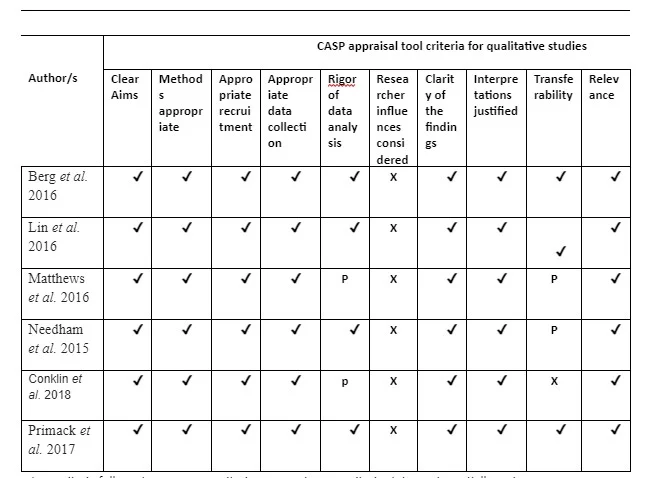
Literature Review Summary
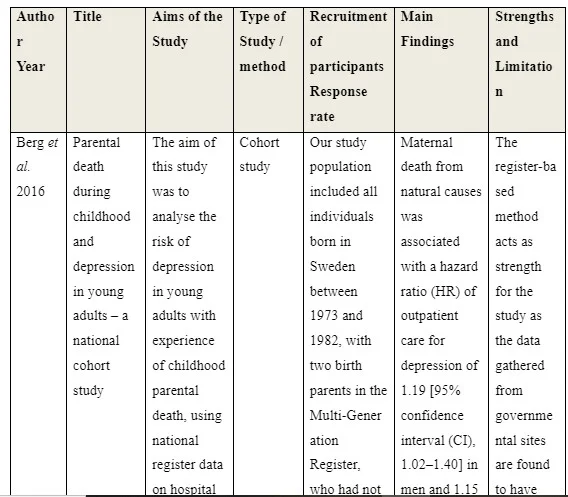
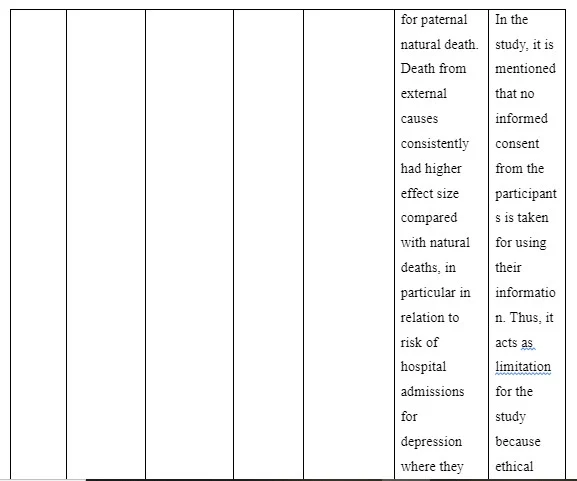
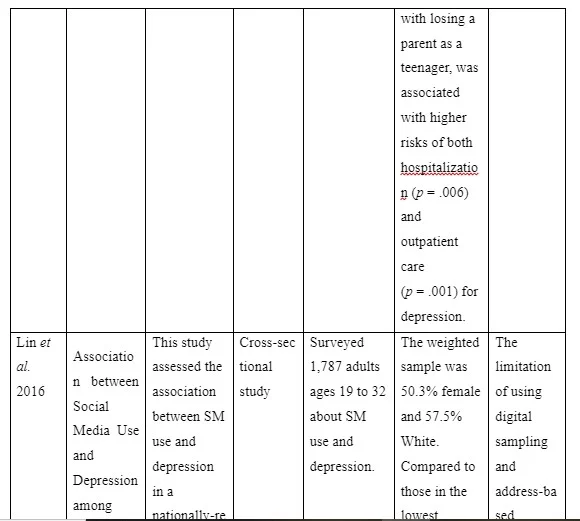
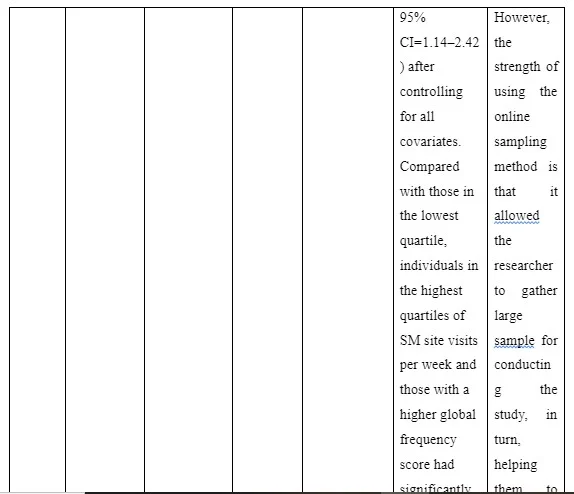

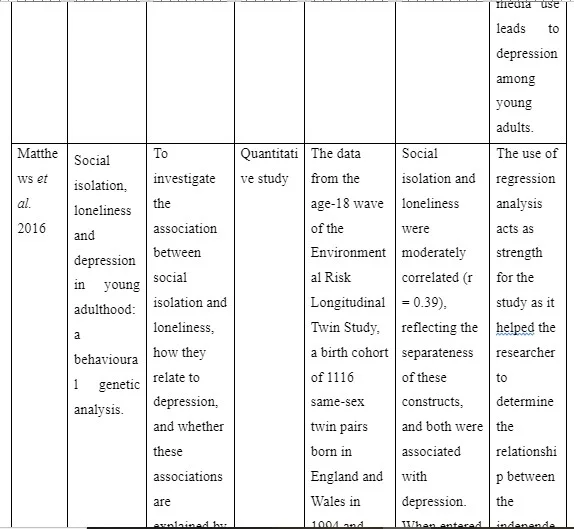
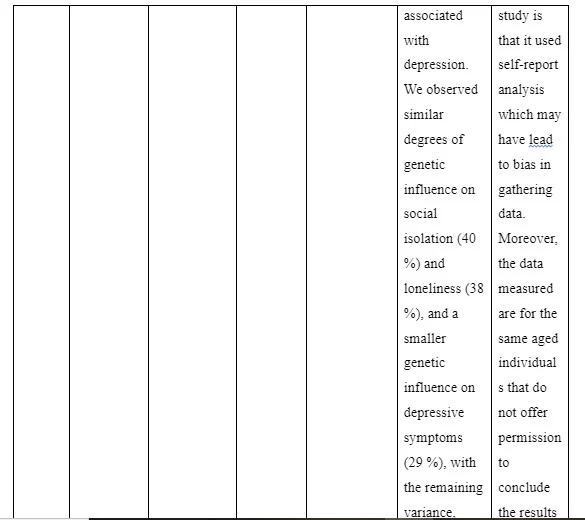
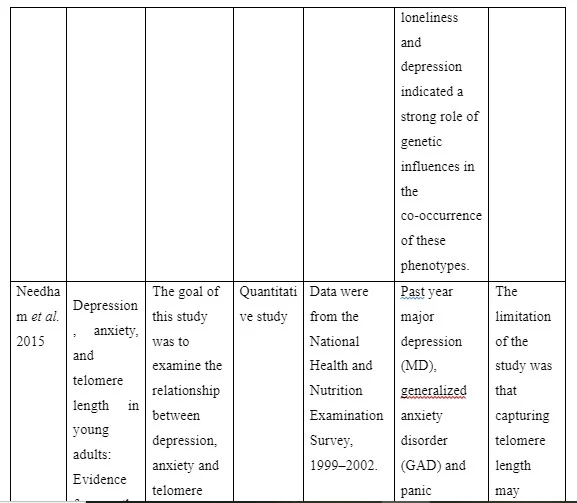
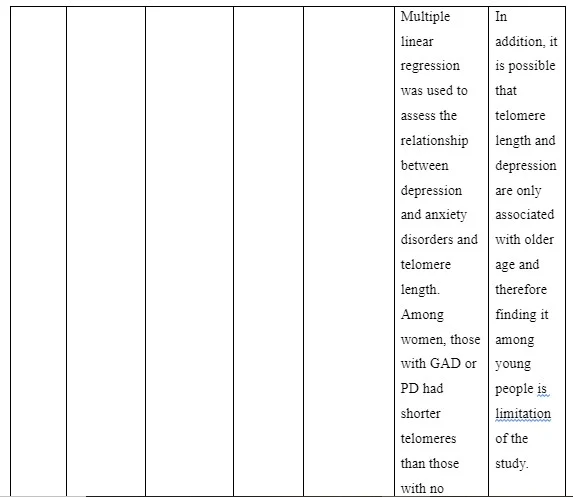
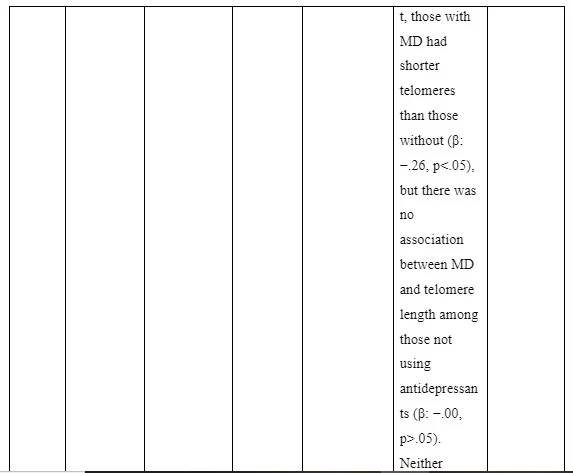
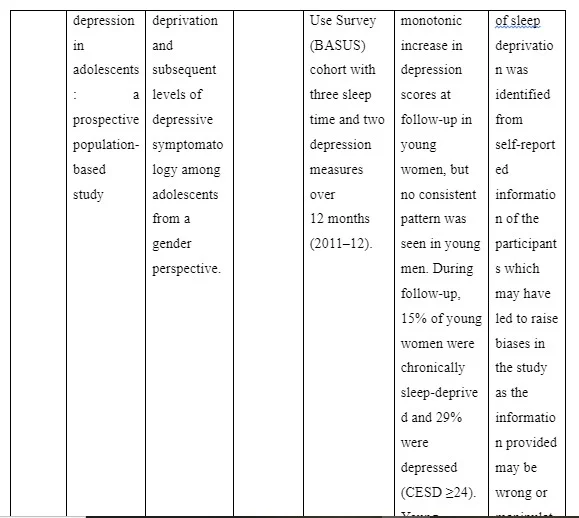
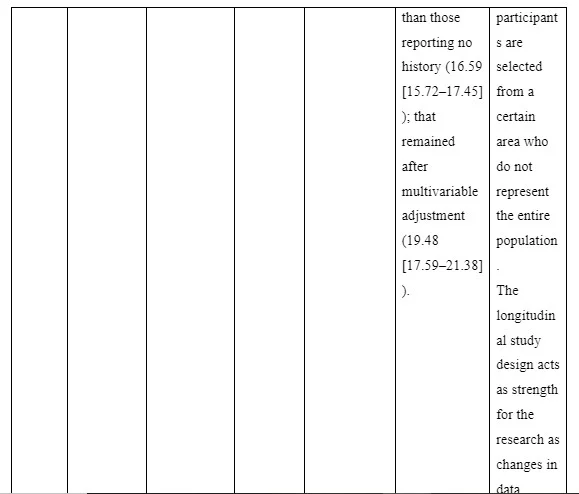
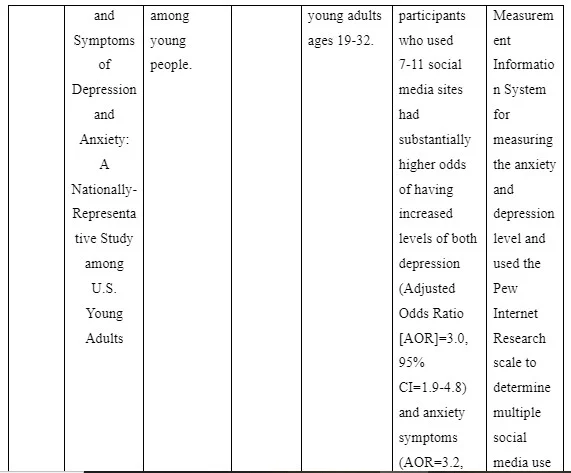
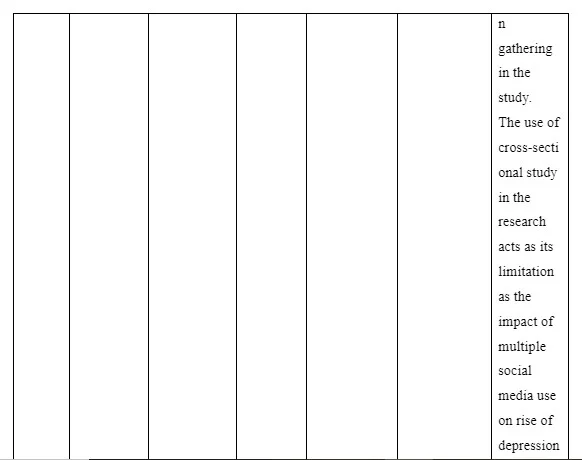
Continue your journey with our comprehensive guide to Exploring Primary Research Methods in Health and Social Care.
- 24/7 Customer Support
- 100% Customer Satisfaction
- No Privacy Violation
- Quick Services
- Subject Experts



